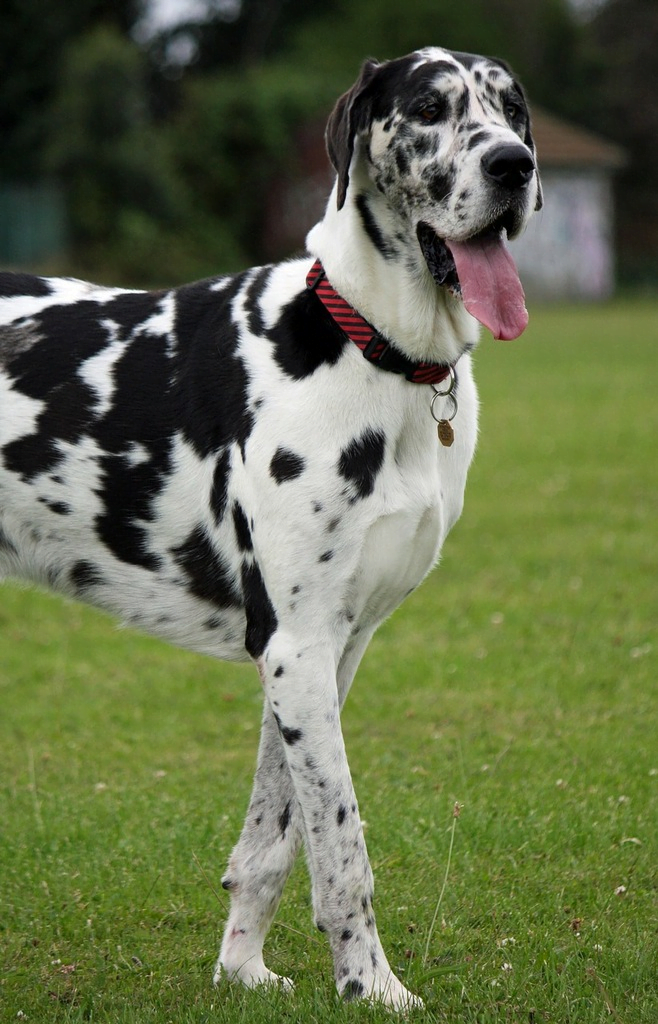Great Danes, often referred to as “gentle giants,” have a storied history that intertwines with European nobility. Originating from Germany, these dogs were initially bred for hunting wild boar and guarding estates. Today, they’re celebrated for their imposing stature, gentle demeanor, and loyalty. Despite their size, Great Danes are known for being affectionate family pets that thrive on human companionship. Their graceful presence and patient nature make them excellent companions, albeit with some unique care requirements due to their size. This post will dive into what makes the Great Dane a remarkable breed, from its historical roots to tips on how to provide the best care for these majestic animals.
Key Takeaways
- Great Danes are a unique breed that combines size, strength, and a gentle demeanor, making them excellent companions for families and individuals alike.
- Prioritizing regular health check-ups and being vigilant about potential breed-specific issues like hip dysplasia and heart conditions can significantly enhance the quality of life for a Great Dane.
- Understanding the needs of a Great Dane, including space to move and a comfortable living environment, is crucial for their physical and mental well-being.
- When considering adding a Great Dane to your family, seeking reputable breeders or adoption agencies is vital to ensure you’re getting a healthy and well-socialized pet.
- Due to their size and potential health issues, owning a Great Dane comes with responsibilities and costs that prospective owners should be prepared for.
- Engaging with the Great Dane community through forums, clubs, or social media can provide invaluable support, advice, and friendship for both new and experienced owners.
Breed Overview
History
Great Danes trace their roots back to Germany, not Denmark as their name might suggest. Initially bred for hunting wild boar and guarding estates, these dogs were valued for their strength and speed. Over time, the breed evolved from a fierce hunter to what is often referred to as a “gentle giant.” This transformation is marked by key historical milestones, including the breed’s recognition by prominent kennel clubs.
The American Kennel Club (AKC) officially recognized the Great Dane in 1887. This acknowledgment cemented their status not just as working dogs but also as cherished companions. Their presence in popular culture, from cartoons to movies, further solidified their image as lovable giants rather than fearsome beasts.
Physical Characteristics
Great Danes are among the largest breeds, with males standing at least 30 inches tall at the shoulder and females not far behind. They can weigh anywhere between 110 to 175 pounds, depending on gender and height. Their long, muscular body and short, sleek coat are distinctive features that contribute to their majestic appearance.
The breed standard recognizes a variety of coat colors and patterns. These include fawn, brindle, blue, black, harlequin (white with black patches), and mantle (black and white). Each color or pattern adds to the unique beauty of these dogs.
Personality and Temperament
Despite their intimidating size, Great Danes are known for their gentle and affectionate nature. They form strong bonds with family members and are known for being patient with children. With proper socialization from a young age, they also get along well with other pets.
Their loyalty is unmatched; they often become protective of their families if they sense danger. However, this protective instinct does not translate into aggression without cause. Instead, it showcases their deep-seated desire to keep loved ones safe. Their friendliness extends beyond the family circle – Great Danes are generally welcoming of strangers unless given a reason not to be.
Health And Care
Common Health Issues
Great Danes, known for their majestic size, face several health challenges. Hip dysplasia, a condition where the hip joint doesn’t fit together perfectly, is common in this breed. Gastric torsion, also known as bloat, is another serious concern that can be life-threatening without immediate care. Heart conditions are prevalent too, making regular veterinary check-ups essential.
Owners should seek genetic testing and health clearances from breeders. This ensures your Great Dane has the best chance at a healthy life.
Dietary Needs
The dietary needs of a Great Dane differ significantly from those of smaller breeds. They require a balanced diet that supports their large frame and energy levels. Overfeeding can lead to obesity and increase the risk of bloat, a condition Great Danes are particularly susceptible to.
Feeding schedules and portion control are crucial. Consult with a veterinarian to develop a diet plan tailored to your dog’s specific needs based on age, weight, and health status.
Exercise Requirements
Despite their size, Great Danes don’t need excessive exercise. Regular, moderate activities keep them healthy and happy. Long walks and play sessions in secure areas are great ways to meet their physical needs without overdoing it.
It’s important not to over-exercise puppies or young dogs. Their bones and joints are still developing, and too much strain can cause damage.
Grooming
Great Danes have relatively low grooming needs thanks to their short coat. Regular brushing helps minimize shedding and keeps the coat shiny and healthy.
Routine nail trimming, ear cleaning, and dental care are also important parts of their grooming routine. These simple steps go a long way in preventing common health issues related to poor hygiene.
Living with a Great Dane
Training and Socialization
Early socialization and obedience training are crucial for Great Danes. These giants possess a sharp intellect and considerable size, making early education essential. Owners should focus on positive reinforcement techniques such as treats and praises. These methods prove effective in promoting good behavior.
Training classes offer significant benefits for both the dog and its owner. They help in molding a well-behaved pet while strengthening the bond between them. A respectful relationship is key to living harmoniously with such a large breed.
Environment
Great Danes require spacious living environments to match their large stature. Homes with access to a securely fenced yard are ideal, providing ample space for exercise and play. Despite their size, Great Danes can adapt well to various living situations, including apartment living, as long as their physical and emotional needs are addressed.
It’s important not to leave Great Danes alone for long periods. They thrive on companionship and may develop separation anxiety if isolated too often. Ensuring they have company most of the time keeps them happy and healthy.
Activities They Enjoy
Great Danes enjoy a variety of activities that cater to their playful and sociable nature. Engaging in interactive games and family outings brings them immense joy. Activities that challenge their minds, like puzzle toys and obedience tasks, keep them mentally stimulated.
Incorporating these gentle giants into daily family life ensures they remain engaged and content. Whether it’s helping with chores or simply lounging together, Great Danes cherish being part of the action.
 Creator: Leyzif2000
Creator: Leyzif2000
Breeder Advice and Adoption
Choosing a Breeder
When looking for a Great Dane puppy, finding a reputable breeder is crucial. These breeders focus on the health, temperament, and adherence to breed standards. They know that these factors are essential for pet parents wanting a healthy and happy dog.
Before making any decisions, ask for health clearances. These documents prove that the puppy’s parents have been tested for common genetic diseases. Also, meeting the puppy’s parents can give you insight into your future pet’s characteristics.
It’s important to visit the breeder’s facility. This allows you to see where your Great Dane puppy has been living. You can observe how they’re socialized and what conditions they’re raised in. A clean environment and well-socialized puppies are good signs of a caring breeder.
Adoption
Adoption is another loving way to bring a Great Dane into your home. Shelters and rescue organizations often have Great Danes looking for new homes. Adopting can be rewarding. It gives dogs a second chance at happiness.
Prepare before adopting by knowing what questions to ask. Learn about the dog’s health history and temperament to ensure they’re a good fit for your family. This preparation helps make the transition smoother for both you and the dog.
Adopting an adult Great Dane has its perks. You can skip the demanding puppy stage. Plus, you’ll already know the dog’s size and personality. This makes it easier to find a pet that matches your lifestyle.
Misc.
Popular Names
Great Danes are often given names that reflect their grand stature and noble personality. Common choices include Titan, Zeus, and Athena for their god-like presence. Others prefer names like Duke, Lady, or Maximus which underscore their regal bearing. It’s important to pick a name that matches the dog’s unique traits and character. There’s also a trend of naming these gentle giants after famous fictional or historical figures known for their size and strength, such as Goliath or Hercules.
Choosing a fitting name adds to the bond between pet and owner. It can also highlight the dog’s individuality.
Fun Facts
Great Danes hold a special place in history and pop culture. Scooby-Doo, perhaps the most famous Great Dane, has brought joy to families around the world with his adventures. These dogs have also set records for their size. One notable Dane named Zeus held the title for the world’s tallest dog at an astounding 44 inches tall at the shoulder.
Despite their massive build, Great Danes possess surprising agility and speed. They were historically bred for hunting wild boar, which explains their swift reflexes.
Common Myths
One common myth about Great Danes is that they’re inherently aggressive due to their size. In truth, they’re known for their gentle and friendly demeanor towards both adults and children. Another misconception is regarding their health; while they do face certain breed-specific challenges, proper care and regular vet check-ups can ensure they lead healthy lives.
The notion that Great Danes need vast amounts of space is also misleading. Though large, they adapt well to various living conditions including apartments. Their calm nature makes them less demanding of space than one might think.
Most Similar Breed
When comparing Great Danes to other breeds, the Mastiff shares many similarities in size and temperament but also showcases distinct differences. Both breeds exhibit a protective nature combined with a calm demeanor towards their family members. However, Great Danes tend to be more sociable and less reserved than Mastiffs.
Historically, Danes were developed from mastiff-like dogs but were bred for speed and hunting capability, setting them apart in function and form from their Mastiff cousins. This breeding history contributes to the unique qualities of modern Great Danes, blending size with grace in a way few other breeds manage.

Top Dog Grooming Tools (Click Here)
Final Remarks
Great Danes are more than just pets; they’re loyal friends with unique needs. You’ve learned about their care, health, and how to find the right breeder or adoption option. This breed requires commitment, but the rewards are immense. They bring joy, companionship, and a touch of elegance to any home willing to accommodate their size and heart.
Now’s your chance to make a difference in a Great Dane’s life. Whether you’re ready to adopt or still considering, further research and connecting with reputable breeders or rescue organizations can pave the way for a fulfilling journey with these gentle giants. Dive in, ask questions, and maybe, just maybe, you’ll find your next furry family member. Let’s make their world as big and loving as they make ours.
Frequently Asked Questions
What is the average lifespan of a Great Dane?
Great Danes typically live between 7 to 10 years. Providing a healthy diet, regular exercise, and routine veterinary care can help maximize their lifespan.
How much exercise does a Great Dane need?
A Great Dane requires at least 30 to 60 minutes of daily exercise. This should include walks and playtime to keep them physically and mentally stimulated.
Are Great Danes suitable for apartment living?
Yes, Great Danes can adapt well to apartment living if they are given enough exercise and attention. They are relatively low-energy indoors but need space to stretch out.
What health issues are common in Great Danes?
Great Danes are prone to certain health issues like hip dysplasia, heart conditions, and bloat. Regular check-ups with a vet can help manage these conditions.
How often should you groom a Great Dane?
Great Danes have short coats that require minimal grooming. A weekly brushing session is sufficient to keep their coat healthy and reduce shedding.
Is it better to adopt a Great Dane or buy from a breeder?
Adopting a Great Dane can be rewarding, giving a dog a second chance at life. However, if you’re looking for a specific lineage or health guarantees, reputable breeders may be the way to go. Always research thoroughly before deciding.
Can Great Danes be trained easily?
Yes, Great Danes are known for their intelligence and eagerness to please, making them relatively easy to train. Consistency and positive reinforcement are key during training sessions.







0 Comments